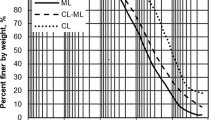Abstract
This paper presents both experimental and numerical studies of three-layered reinforced soil slopes consisting of one sandy layer sandwiched between two cohesive–frictional soils. Geosynthetic reinforcements are provided at the interfaces. Small-scale shaking table tests are performed to evaluate different stability parameters like horizontal deformation, root-mean-square acceleration amplification factor, and crest deformation of the slope. Water content, base shaking acceleration, frequencies, and quantity and type of reinforcements are varied to perform the tests. The inclusion of reinforcements increases the strength of the slope enormously which is represented in the paper in terms of different parameters. Geogrid reinforcement is found to be better in comparison with geotextile reinforcement. To verify the results obtained from the present experimental study, a numerical model is developed using PLAXIS 2D and the acceptability of the study is discussed.






























Similar content being viewed by others
References
Fellenius W (1936) Calculation of the stability of earth dams. In: Proceedings of the second congress of large dams, Washington, DC, vol 4, pp 445–463
Bishop AW (1955) The use of slip circle in the stability analysis of earth slopes. Geotechnique 5(1):7–17
Janbu N (1954) Applications of composite slip surfaces for stability analysis. In: Proceedings of the stability of earth slopes, Stockholm, Sweden vol 3, pp 43–49
Morgenstern NR, Price VE (1965) The analyses of the stability of general slip surfaces. Geotechnique 15(1):79–93
Clough RW, Pirtz D (1956) Earthquake resistance of rock-fill dams. Soil Mechanics and Foundations Division 82(2):1–26
Seed HB, Clough RW (1963) Earthquake resistance of sloping core dams. J Soil Mech Found Div ASCE 89(1):209–242
Hong YS, Chen RH, Wu CS, Chen JR (2005) Shaking table tests and stability analysis of steep nailed slopes. Can Geotech J 42(5):1264–1279
Nova-Roessig L, Sitar N (2006) Centrifuge model studies of the seismic response of reinforced soil slopes. J Geotech Geoenviron Eng 132(3):388–400
Koga Y, Matsuo O (1990) Shaking table tests of embankment resting on liquefiable sandy ground. Soils Found 30(4):162–174
Wartman J, Seed RB, Bray JD (2003) Inclined plane studies of the Newmark sliding block procedure. J Geotech Geoenviron Eng 129(8):673–684
Lin ML, Wang KL (2006) Seismic slope behavior in a large-scale shaking table model test. Eng Geol 86(2):118–133
Guler E, Enunlu AK (2009) Investigation of dynamic behavior of geosynthetic reinforced soil retaining structures under earthquake loads. Bull Earthq Eng 7(3):737–777
Perez A, Holtz RD (2004) Seismic response of reinforced steep soil slopes: results of shaking table study. In: Yegian MK, Kavazanjian E (eds) Geotechnical engineering for transportation projects, vol 126. ASCE GSP, Reston, pp 1664–1672
Lin Y, Leng W, Yang G, Li L, Yang J (2015) Seismic response of embankment slopes with different reinforcing measures in shaking table tests. Nat Hazards 76(2):791–810
Chanda N, Ghosh S, Pal M (2017) Response of Slope Made Up of Soil and Other Waste Materials under Sinusoidal Motion. Adv Mater Sci Eng 2017, Article ID 2456724
Srilatha N, Latha GM, Puttappa CG (2016) Seismic response of soil slopes in shaking table tests: effect of type and quantity of reinforcement. Int J Geosynth Ground Eng 2:33
Hazari S, Ghosh S, Sharma RP (2019) Experimental and numerical study of soil slopes at varying water content under dynamic loading condition. Int J Civ Eng 18(2):215–222
Man-Yu W, Yong L, Ya-Nan D, Bao-Long Y (2020) Probabilistic stability analyses of multi-stage soil slopes by bivariate random fields and finite element methods. Comput Geotech 122:103529
PLAXIS 2D 8.2 [Computer software]. Delft, Netherlands, Plaxis
IS: 1498 (1970) (reaffirmed 1987), Indian standard classification and identification of soils for general engineering purposes. BIS, New Delhi
ASTM D4595–11 (2011) Standard test method for tensile properties of geotextiles by the wide-width strip method. ASTM International, West Conshohocken, PA
ASTM D6637–01 (2001) Standard test method for determining tensile properties of geogrids by the single or multi-Rib tensile method. ASTM International, West Conshohocken, PA
Pasternack SC, Gao S (1988) Numerical methods in the stability analysis of slopes. Comput Struct 30(3):573–579
Matsui T, San KC (1992) Finite element slope stability analysis by shear strength reduction technique. Soils Found 32(1):59–70
Duncan JM (1996) State of the art: limit equilibrium and finite element analysis of slopes. J Geotech Eng 122(7):577–596
Ugai K, Leshchinsky D (1995) Three-dimensional limit equilibrium and finite element analyses: a comparison of results. Soils Found 35(4):1–7
Griffiths DV, Lane PA (1999) Slope stability analysis by finite elements. Geotechnique 49(3):387–403
Lane P, Griffiths DV (2000) Assessment of stability of slopes under drawdown conditions. J Geotech Geoenviron Eng 126(5):443–450
Griffiths DV, Fenton GA (2004) Probabilistic slope stability analysis by finite elements. J Geotech Geoenviron Eng ASCE 130(5):507–518
Li X (2007) Finite element analysis of slope stability using a nonlinear failure criterion. Comput Geotech 34(3):127–136
Hammouri A, Malkawi AIH, Yamin MMA (2008) Stability analysis of slopes using the finite element method and limit equilibrium approach. Bull Eng Geol Environ 67:471–478
Chatterjee D, Krishna AM (2018) Stability analysis of two-layered nonhomogeneous slopes. Int J Geotech Eng. https://doi.org/10.1080/19386362.2018.14.65686
Author information
Authors and Affiliations
Corresponding author
Ethics declarations
Conflict of interest
The authors declare that they have no conflict of interest.
Rights and permissions
About this article
Cite this article
Jana, K., Hazari, S. & Ghosh, S. Experimental and numerical studies of three-layered unreinforced and geosynthetic-reinforced soil slopes. Innov. Infrastruct. Solut. 6, 41 (2021). https://doi.org/10.1007/s41062-020-00408-6
Received:
Accepted:
Published:
DOI: https://doi.org/10.1007/s41062-020-00408-6




